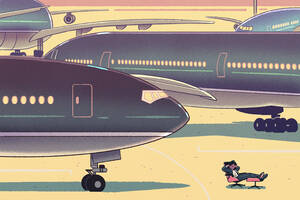What prompted Musk to choose to veer from PayPal to SpaceX, to Tesla? For that matter, what makes anybody choose the next move in their career?
Dashun Wang, an associate professor of management and organizations at the Kellogg School, wondered if such seemingly mercurial choices could be modeled scientifically. Musk, whom Wang considers his “personal hero,” may be an extreme case. But every serial entrepreneur, artist, or scientist—that is, anyone whose job involves discovery, experimentation, and deciding what to work on next—thrives on seeking out new challenges.
And understanding how professional innovators move from project to project has implications beyond the merely philosophical.
“If we know individually how these people tend to change direction, then that determines collectively where things are going,” Wang says.
A Method to the Madness
So how do innovative people choose their next career move? Is it really as random as it often seems?
Wang, who is also a faculty member at the Northwestern Institute on Complex Systems, is used to tackling questions that might seem too ambiguous to yield to quantitative analysis. “We’re the unreasonable optimists,” Wang says. “We figured that there’s got to be some pattern that we can document.”
Wang and his coauthors Tao Jia of Southwest University in China and Boleslaw K. Szymanski of Rensselaer Polytechnic Institute began by narrowing their investigation to one particular domain of innovators: physicists.
This scientific community uses a detailed set of numerical codes—the Physics and Astronomy Classification Scheme (PACS)—to define research topics, much like the Dewey Decimal System uses numbers to categorize the subject matter of library books. The researchers used these codes to analyze how the work of the approximately 10,000 physicists in the database changed from project to project.
“We realized that there’s a remarkable amount of regularity in what we choose to do next in our careers,” Wang says.
Choosing Your Next Career Move
Several trends emerged from their analysis. The first is that most physicists’ research stayed relatively constrained within particular disciplines or domains.
“What this means is that most people”—even innovators—“don’t change” as much as they conceivably could, explains Wang, who holds a PhD in physics himself.
When researchers did shift to a new project, it tended to be one that was very close to a previous project in terms of what Wang calls “knowledge space.”
But which previous project? Somewhat unexpectedly, according to the data, the physicists’ most recent projects exerted the most dominant influence on what project they chose next.
According to Wang, the physicists’ decisions go against a common intuition about innovators’ decision-making. That idea posits that the more time is spent moving in one direction, the further one gets ahead of the competition, and the more incentive there is to choose new projects that align with that initial direction. If physicists were trying to maximize their hard-won knowledge about that topic, they would double down on projects in similar domains as their earliest efforts.
“So your fourth project should more likely be similar to your first project than your third,” Wang says.
Instead, he says, “what we find in the data is the other way around. If you study something, the next topic you study is predominantly determined by what you studied last—not what you studied first.”
Next Moves
This recency effect likely applies even to apparent outliers like Musk. Take his latest venture: a startup called Neuralink, specializing in brain–computer interface technology with the goal of allowing human brains to keep up with artificial intelligence. It seems wholly unrelated to Musk’s prior successes with online payments, electric cars, and rocketry. However, one of Musk’s lesser-known projects—a nonprofit research company called OpenAI, focusing on artificial intelligence—does share clear similarities with Neuralink. Musk’s involvement in OpenAI began just two years before he launched Neuralink.
Still, while Wang’s model sheds new light on how innovators choose their next projects, it doesn’t speak to how they should choose—both to move forward an entire field and their own careers.
“Let’s first understand how our interests change during the course of our careers—then we can debate about what the best strategy is for making those changes,” says Wang.




